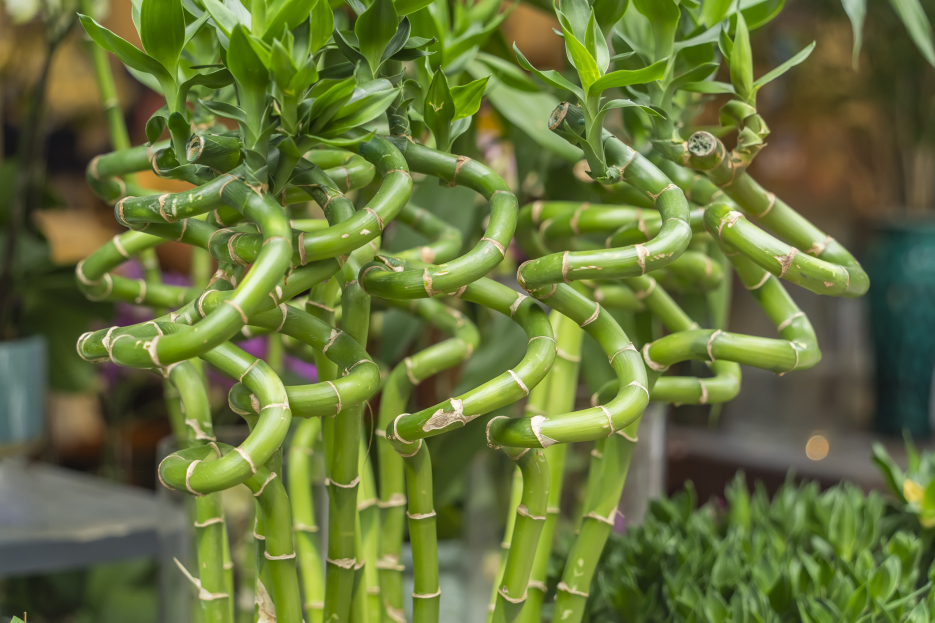
Dracaena sanderiana, more commonly known as Lucky Bamboo, is a popular plant believed to bring good fortune and positive energy. Despite its bamboo-like appearance, it’s not actually bamboo but a resilient member of the Dracaena family. With its graceful, upright stalks and vibrant green leaves, Lucky Bamboo is a beautiful addition to homes, offices, and even feng shui arrangements. It’s also incredibly easy to care for — here’s how to keep yours thriving!
Lucky Bamboo prefers bright, indirect sunlight. Place it near a window where it can receive gentle, filtered light — an east-facing window works perfectly. While it can tolerate low light, too little light may cause slow growth and pale leaves. On the other hand, direct sunlight can scorch the leaves, leading to brown tips. If your space lacks natural light, a grow light can help provide the necessary brightness without the harshness of direct rays.
One of the most unique features of Lucky Bamboo is that it can grow either in water or soil, but the watering approach differs slightly depending on the method you choose.
If growing in water, ensure the roots are submerged, but the stalks remain above the waterline to prevent rot. Use distilled or filtered water to avoid chlorine & fluoride, which can damage the plant. Change the water every 7-10 days to keep it fresh and prevent algae buildup.
If you’re growing Lucky Bamboo in soil, treat it like any other Dracaena. Keep the soil lightly moist but never soggy. Water when the top inch of soil feels dry, and ensure the pot has good drainage to avoid root rot.
While Lucky Bamboo is commonly grown in water, it can also thrive in soil. If you choose this method, use a well-draining potting mix — a blend for houseplants or Dracaena works well. A pot with drainage holes is essential to prevent excess water from collecting at the bottom.
If you’re keeping your Lucky Bamboo in water, use a clear container with decorative pebbles or marbles to hold the stalks in place. Ensure the container is stable to prevent the plant from toppling over.
Lucky Bamboo enjoys warm, humid environments. Keep it in a room with temperatures between 65-90°F (18-32°C). Avoid exposing the plant to cold drafts or sudden temperature changes — anything below 50°F (10°C) can cause the leaves to yellow and drop.
Humidity isn’t a big concern, but if your home is very dry, an occasional misting can help keep the leaves vibrant. Bathrooms or kitchens, where humidity levels are naturally higher, make great spots for Lucky Bamboo.
Lucky Bamboo doesn’t need much fertilizer to thrive. If growing in water, add a drop of liquid houseplant fertilizer once a month to provide nutrients. For soil-grown plants, use a balanced, water-soluble fertilizer diluted to half strength every 4 to 6 weeks during the growing season (spring and summer). Avoid over-fertilizing, as this can cause leaf discoloration.
Lucky Bamboo requires minimal pruning. If leaves turn yellow or brown, trim them off with clean scissors. You can also trim the stalks to control the height or shape. When cutting the stalk, make sure to cut above a node (the raised ring around the stem), as this will encourage new growth.
To keep the plant looking fresh, wipe the leaves with a damp cloth occasionally to remove dust.
Yellowing leaves are usually a sign of too much direct sunlight, poor water quality, or over-fertilizing. Try adjusting the light, switching to distilled water, or cutting back on fertilizer.
Brown leaf tips often indicate low humidity or fluoride in the water. Mist the plant occasionally and ensure you’re using fluoride-free water.
If the stalks become mushy or discolored, this is a sign of root rot. Remove any affected stalks, refresh the water, and ensure the remaining healthy stalks stay upright and above the waterline.
Unfortunately, Lucky Bamboo is mildly toxic to cats and dogs if ingested. It contains saponins, which can cause digestive upset, drooling, and vomiting. Keep it out of reach of curious pets or children to avoid any mishaps.